Corona Australis is a small, faint constellation in the southern sky. Its name means “the southern crown” in Latin. It is located between the constellations Sagittarius and Scorpius.
Corona Australis is said to represent the crown worn by the centaur represented by Sagittarius by some sources, but the constellation is not really tied to any particular myth. Sometimes it is also called Corona Austrina.
Corona Australis was first catalogued by the Greek astronomer Ptolemy in the 2nd century, along with the constellation representing the northern crown, Corona Borealis.
Facts, location and map
Corona Australis is one of the smallest constellations in the sky. Only the 80th in size, it occupies an area of 128 square degrees.
It lies in the third quadrant of the southern hemisphere (SQ3) and can be seen at latitudes between +40° and -90°. The neighboring constellations are Ara, Sagittarius, Scorpius, and Telescopium.
The constellation name Corona Australis is pronounced /koʊˈroʊnə ɔːˈstrælɪs/. In English, the constellation is known as the Southern Crown. The genitive form of Corona Australis, used in star names, is Coronae Australis (pronunciation: /koʊˈroʊniː ɔːˈstrælɪs/). The three-letter abbreviation, adopted by the International Astronomical Union (IAU) in 1922, is CrA.
Corona Australis does not have any stars brighter than magnitude 3.00 or located within 10 parsecs (32.6 light years) of Earth. The brightest star in the constellation is Alpha Coronae Australis, also known as Meridiana. The nearest star is HD 166348 (spectral class K6Vk), located at a distance of 42.26 light years from Earth.
The constellation contains one formally named star. The star name approved by the International Astronomical Union (IAU) is Meridiana.
Corona Australis has two stars with known planets. One of these, HD 166724, is a K-class dwarf with a long-period, wide-orbiting planet that is considered one of the three most eccentric planets with a period larger than 5 years. The planet was discovered in 2012.
Corona Australis belongs to the Hercules family of constellations, along with Aquila, Ara, Centaurus, Corvus, Crater, Crux, Cygnus, Hercules, Hydra, Lupus, Lyra, Ophiuchus, Sagitta, Scutum, Sextans, Serpens, Triangulum Australe, and Vulpecula.
Corona Australis does not contain any Messier objects. The best known deep sky objects in the constellation are the Corona Australis Nebula and the Coronet Cluster. There is one meteor shower associated with the constellation, the Corona Austrinids.
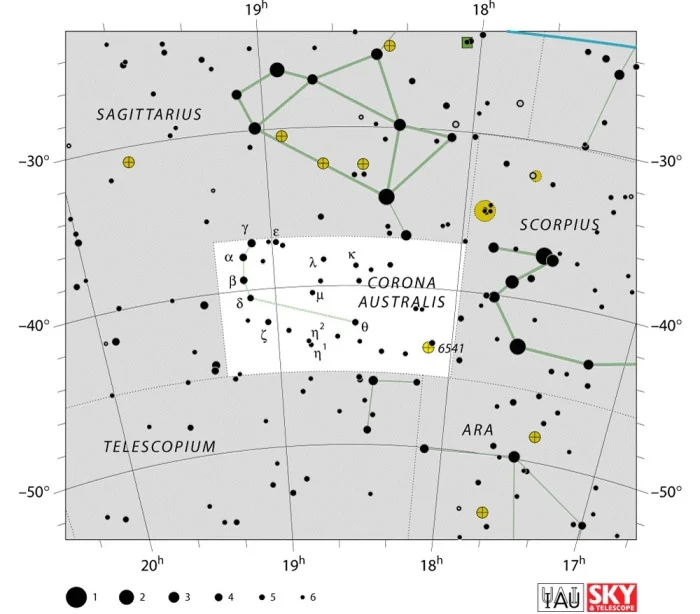
Corona Australis constellation map by IAU and Sky&Telescope magazine
Myth
Corona Australis, the Southern Crown, was known by the Greeks as a wreath, not a crown. Before Ptolemy introduced its stars as a separate constellation, Corona Australis was known as a circlet of stars near the forefeet of the centaur represented by the neighbouring constellation Sagittarius.
The constellation is sometimes associated with the myth of Dionysus. In the story, Corona Australis represents the crown the god placed in the sky after freeing his mother Semele from the god of the underworld, Hades. This particular myth, however, is also sometimes associated with the Northern Crown, Corona Borealis.
Ptolemy originally assigned 13 stars to the constellation Corona Australis, but one of them was later moved to the constellation Telescopium, where it became Alpha Telescopii.
Corona Australis stars
Meridiana – α Coronae Australis (Alpha Coronae Australis)
Alpha Coronae Australis, formally known as Meridiana, is a class A2V star with an apparent magnitude of 4.10. It is 130 light years distant.
It is the only named star in the constellation. It got its name, Alphekka Meridiana (Alphekka South) after Alphecca, the brightest star in the northern constellation Corona Borealis.
β Coronae Australis (Beta Coronae Australis)
Beta Coronae Australis is a K-type bright giant (spectral type K0II) with an apparent magnitude of 4.117, approximately 510 light years distant. The star has an absolute magnitude of -1.8.
R Coronae Australis
R Coronae Australis is a well-known variable star belonging to the spectral type A5IIev, approximately 26.8 light years distant from Earth.
It is a relatively young star that is still accreting material onto its surface. The star has a mean apparent magnitude of 11.5. It is located in the star forming nebulosity NGC 6726/27/29.
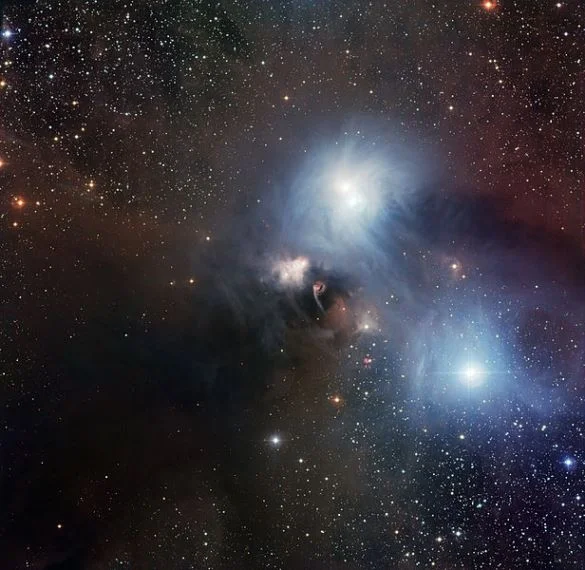
The nearby star-forming region around the star R Coronae Australis imaged by the Wide Field Imager (WFI) on the MPG/ESO 2.2-metre telescope at ESO’s La Silla Observatory in Chile. This picture, which covers a field of 33.7 x 31.9 arcminutes (about the diameter of the full Moon), is a combination of twelve CCD frames, 67 megapixels each, taken through B, V and R filters, with four exposures of five minutes each. Image: European Southern Observatory
R Coronae Australis is a Herbig Ae/Be star, which is to say a pre-main sequence star, still in the star formation stage, belonging to the spectral type A or B, less than 10 million years in age, surrounded by a circumstellar disk and embedded in an envelope of gas and dust.
Herbig stars have hydrogen and calcium emission lines observed in their spectra, and they are not burning hydrogen in their centre.
RX J1856.5-3754
RX J1856.5-3754 is a neutron star in the constellation Corona Australis. Located at an estimated distance of 400 light years from Earth, it is the closest neutron star to our solar system. It is moving across the sky at the speed of 108 km/s. The star is believed to have been formed by a supernova of its companion star approximately a million years ago.
RX J1856.5-3754 was first discovered in 1992. Since it was initially believed to be only about 4-8 kilometres in diameter, too small for a neutron star, it was considered to be a candidate for a quark star instead. Further observations, however, confirmed that it was indeed a neutron star and that its diameter was larger, closer to 14 kilometres.
RX J1856.5-3754 is one of the Magnificent Seven, a group of young, cooling, isolated neutron stars emitting soft X-rays, located within 200 to 500 parsecs to Earth. The stars are also known as XDINS (X-ray Dim Isolated Neutron Stars) or XTINS (X-ray Thermal Neutron Stars).
Deep sky objects in Corona Australis
Corona Australis Nebula
Corona Australis Nebula is a bright reflection nebula, about 420 light years distant, formed by several bright stars caught up in a dark cloud of dust. The cloud is a star-forming region, with clusters of young stars embedded within it.
The Corona Australis Nebula consists of three nebulous regions, NGC 6726, NGC 6727, and NGC 6729, that were originally discovered by the German astronomer Johann Friedrich Julius Schmidt in 1861. The molecular cloud complex in the region is one of the nearest areas with recent or ongoing intermediate and low-mass star formation.
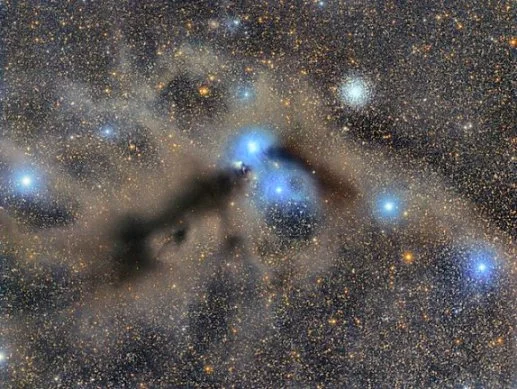
The Corona Australis Molecular Cloud is a dusty nebula and star-forming region with both reflection and absorption components. This image here has a combined exposure of nearly 4 hours of data, taken under very good sky conditions in Mersing, Malaysia. NGC 6723, an ostensibly adjacent globular cluster (but in fact much farther away from Earth than the nebula), is also visible here on the top right of the blue reflection nebula, NGC 6726/67. Image: Wikimedia Commons/Ivan Bok (CC BY 4.0)
NGC 6541
NGC 6541 is a large, bright globular cluster. It was first discovered by the Italian astronomer Niccolò Cacciatore in March 1826 and then later independently found by James Dunlop in July 1826. Cacciatore initially believed the object to be a nebula.
The cluster lies about halfway between the stars Theta Coronae Australis and Theta Scorpii.
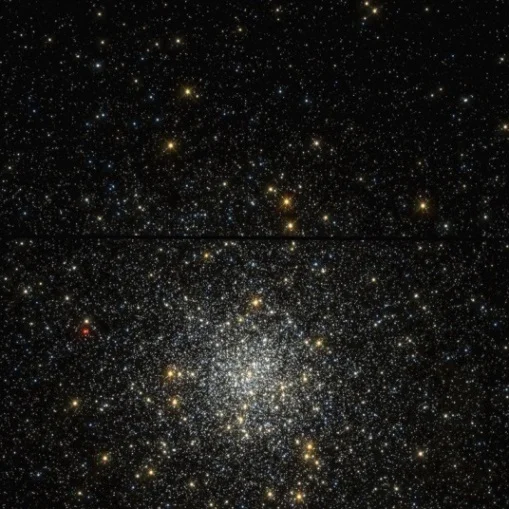
Globular cluster NGC 6541 in Corona Australis. Based on observations made with the NASA/ESA Hubble Space Telescope, and obtained from the Hubble Legacy Archive, which is a collaboration between the Space Telescope Science Institute (STScI/NASA), the Space Telescope European Coordinating Facility (ST-ECF/ESA) and the Canadian Astronomy Data Centre (CADC/NRC/CSA).
NGC 6726/NGC 6727
The reflection nebula NGC 6726/6727 is illuminated by the star TY Coronae Australis, a variable star with an apparent magnitude varying between 8.8 and 12.6, and HD 176386, which is a Herbig Ae/Be star, like R Coronae Australis.
NGC 6729 (Caldwell 68)
NGC 6729 is a fan-shaped reflection/emission nebula in Corona Australis, found about seven and a half degrees from the star Zeta Sagittarii. The nebula lies between the stars R Coronae Australis and another variable star, T Coronae Australis.
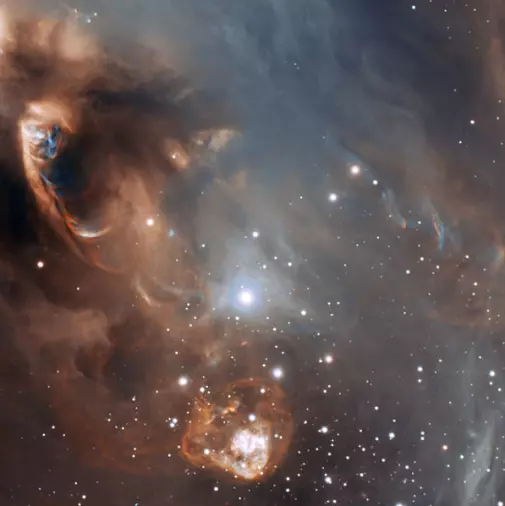
This very detailed false-colour image from ESO’s Very Large Telescope shows the dramatic effects of very young stars on the dust and gas from which they were born in the star-forming region NGC 6729. The baby stars are invisible in this picture, being hidden behind dust clouds at the upper left of the picture, but material they are ejecting is crashing into the surroundings at speeds of that can be as high as one million kilometres per hour. This picture was taken by the FORS1 instrument and records the scene in the light of glowing hydrogen and sulphur. Image: ESO
Coronet cluster
The Coronet cluster is a small open star cluster in Corona Australis. It is approximately 420 light years distant. The cluster lies at the heart of the constellation. It is one of the nearest known regions with ongoing star formation.
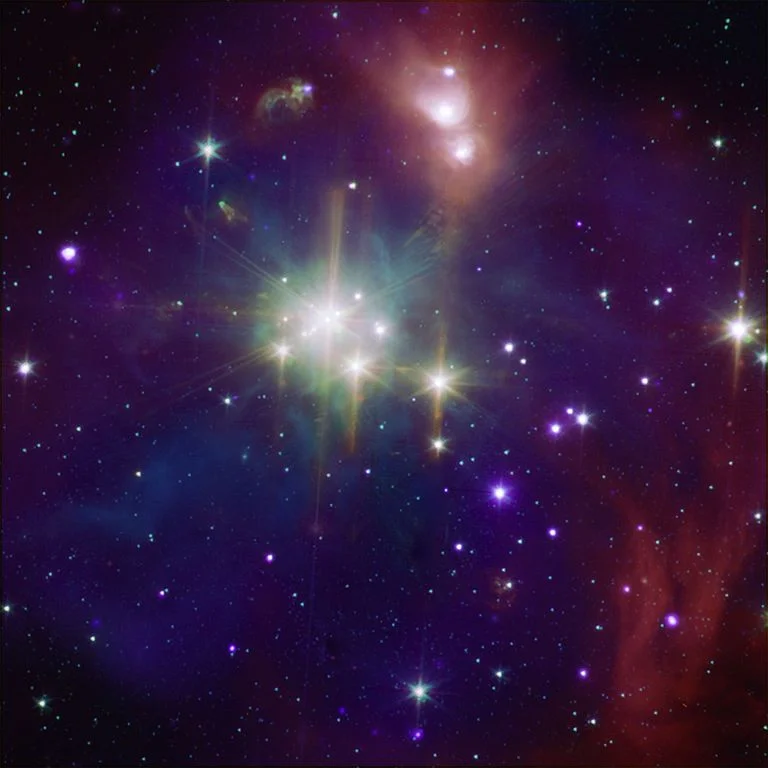
While perhaps not quite as well known as its star-formation cousin Orion, the Corona Australis region (containing, at its heart, the Coronet cluster) is one of the nearest and most active regions of ongoing star formation. At only about 420 light-years away, the Coronet is over three times closer than the Orion nebula is to Earth. The Coronet contains a loose cluster of a few dozen young stars with a wide range of masses and at various stages of evolution, giving astronomers an opportunity to observe embryonic stars simultaneously in several wavelengths. This composite image shows the Coronet in X-rays from Chandra (purple) and infrared from Spitzer (orange, green, and cyan). The Spitzer image shows young stars plus diffuse emission from dust. Due to the host of young stars in different life stages in the Coronet, astronomers can use these data to pinpoint details of how the youngest stars evolve. Image: NASA/CXC/J. Forbrich, NASA/JPL-Caltech L.Allen (Harvard-Smithsonian CfA), IRAC GTO